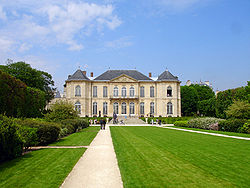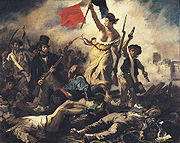
Faubourg Saint-Germain
Encyclopedia
.jpg)

Paris
Paris is the capital and largest city in France, situated on the river Seine, in northern France, at the heart of the Île-de-France region...
. The Faubourg has long been known as the favorite home of the French high nobility and hosts many aristocratic Hôtels particuliers. It is currently part of the 7th arrondissement.
History
In its early history, Faubourg Saint-Germain used to be an agricultural suburb of Paris, lying west of the historical Saint-Germain-des-PrésSaint-Germain-des-Prés
Saint-Germain-des-Prés is an area of the 6th arrondissement of Paris, France, located around the church of the former Abbey of Saint-Germain-des-Prés....
urban district.
In 1670, Louis XIV
Louis XIV of France
Louis XIV , known as Louis the Great or the Sun King , was a Bourbon monarch who ruled as King of France and Navarre. His reign, from 1643 to his death in 1715, began at the age of four and lasted seventy-two years, three months, and eighteen days...
initiated a project of grandiose home and hospital for aged and unwell soldiers: the Invalides. The king chose a site at the western end of the Faubourg and comissionned architect
Architect
An architect is a person trained in the planning, design and oversight of the construction of buildings. To practice architecture means to offer or render services in connection with the design and construction of a building, or group of buildings and the space within the site surrounding the...
Libéral Bruant
Libéral Bruant
Libéral Bruant , was a French architect best known as the designer of the Hôtel des Invalides, Paris, now dominated by the dome erected by Jules Hardouin Mansart, his collaborator in earlier stages of the construction...
. The enlarged project was completed in 1676, the river front measured 196 metres and the complex had fifteen courtyards, the largest being the cour d'honneur
Cour d'Honneur
Cour d'Honneur is the architectural term for defining a three-sided courtyard, created when the main central block, or corps de logis, is flanked by symmetrical advancing secondary wings, containing minor rooms...
("court of honour") for military parades. Jules Hardouin Mansart
Jules Hardouin Mansart
Jules Hardouin-Mansart was a French architect whose work is generally considered to be the apex of French Baroque architecture, representing the power and grandeur of Louis XIV...
assisted the aged Bruant, and the chapel was finished in 1679 to Bruant's designs after the elder architect's death. The construction of the Invalides defined a new district to urbanized offering large empty spaces between the new monument and the old city limit: the Faubourgs history had started.
During the 17th century, French high nobility started to move from the central Marais
Le Marais
Le Marais is a historic district in Paris, France. Long the aristocratic district of Paris, it hosts many outstanding buildings of historic and architectural importance...
, the then-aristocratic district of Paris where nobles used to build their urban mansions (see Hotel de Soubise
Hôtel de Soubise
The Hôtel de Soubise is a city mansion entre cour et jardin , located at 60 rue des Francs-Bourgeois, in the IIIe arrondissement of Paris....
) to the clearer, less populated and less polluted Faubourg Saint-Germain that soon became the new residence of French highest nobility. The district became so fashionable within the French aristocracy
Aristocracy
Aristocracy , is a form of government in which a few elite citizens rule. The term derives from the Greek aristokratia, meaning "rule of the best". In origin in Ancient Greece, it was conceived of as rule by the best qualified citizens, and contrasted with monarchy...
that the phrase le Faubourg has been used to describe French nobility ever since. The oldest and most prestigious families of the French nobility built outstanding residences in the area such as the Hôtel Matignon
Hôtel Matignon
The Hôtel Matignon is the official residence of the Prime Minister of France. It is located in the VIIe arrondissement of Paris, France.The address of Hotel Matignon is 57 rue de Varenne, Paris, France.-History:...
, the Hôtel de Salm or the Hôtel Biron
Hôtel Biron
The Hôtel Biron is an hôtel particulier in the rue de Varenne, Paris VIIème, that was built by Jacques Gabriel and his associate designer Jean Aubert, in 1728-31 Since 1919 it has housed the Musée Auguste Rodin....
.

French Revolution
The French Revolution , sometimes distinguished as the 'Great French Revolution' , was a period of radical social and political upheaval in France and Europe. The absolute monarchy that had ruled France for centuries collapsed in three years...
many of these mansions, offering magnificent inner spaces, many receptions rooms and exquisite decoration, were confiscated and turned into national institutions. The French expression "les ors de la Republique" (literally "the golds of the Republic"), referring to the luxurious environment of the national palaces (outstanding official residences and priceless works of art) comes from that time.
During the Restoration
Bourbon Restoration
The Bourbon Restoration is the name given to the period following the successive events of the French Revolution , the end of the First Republic , and then the forcible end of the First French Empire under Napoleon – when a coalition of European powers restored by arms the monarchy to the...
of the Bourbon
House of Bourbon
The House of Bourbon is a European royal house, a branch of the Capetian dynasty . Bourbon kings first ruled Navarre and France in the 16th century. By the 18th century, members of the Bourbon dynasty also held thrones in Spain, Naples, Sicily, and Parma...
dynasty
Dynasty
A dynasty is a sequence of rulers considered members of the same family. Historians traditionally consider many sovereign states' history within a framework of successive dynasties, e.g., China, Ancient Egypt and the Persian Empire...
, the Faubourg recovered its past glory as the most exclusive high nobility district of Paris. Moreover, home to the Ultra
Ultra-royalist
Ultra-Royalists or simply Ultras were a reactionary faction which sat in the French parliament from 1815 to 1830 under the Bourbon Restoration...
Party, it was the political center of the country. The Ultra pushed towards counter-revolutionary laws, reinforcing Catholic Church's power (Anti-Sacrilege Act
Anti-Sacrilege Act
The Anti-Sacrilege Act was a French law against blasphemy and sacrilege passed in January 1825 under King Charles X. The law was never applied and was later revoked at the beginning of the July monarchy under King Louis-Philippe.-The draft bill:In April 1824, King Louis XVIII's government, headed...
) and voting the infamous Loi du Milliard aux émigrés (literally the Emigrates' Billion Act) which was made to compensate French nobility for its Revolutionary era's loss in terms of fortune and land.
But after the Fall of Charles X during the July Revolution
July Revolution
The French Revolution of 1830, also known as the July Revolution or in French, saw the overthrow of King Charles X of France, the French Bourbon monarch, and the ascent of his cousin Louis-Philippe, Duke of Orléans, who himself, after 18 precarious years on the throne, would in turn be overthrown...
, the district lost most of its political influence. During the July Monarchy
July Monarchy
The July Monarchy , officially the Kingdom of France , was a period of liberal constitutional monarchy in France under King Louis-Philippe starting with the July Revolution of 1830 and ending with the Revolution of 1848...
, from 1830 to 1848, when the junior Orleanist
House of Orleans
Orléans is the name used by several branches of the Royal House of France, all descended in the legitimate male line from the dynasty's founder, Hugh Capet. It became a tradition during France's ancien régime for the duchy of Orléans to be granted as an appanage to a younger son of the king...
branch held the throne, the Faubourg was politically marginalized
Marginalization
In sociology, marginalisation , or marginalization , is the social process of becoming or being made marginal or relegated to the fringe of society e.g.; "the marginalization of the underclass", "marginalisation of intellect", etc.-Individual:Marginalization at the individual level results in an...
, many noble family withdrawing from active participation in political life to their castles, urban mansions in the Faubourg and passive but brilliant social life. Therefore, the Faubourg remained the center of French upper class
Upper class
In social science, the "upper class" is the group of people at the top of a social hierarchy. Members of an upper class may have great power over the allocation of resources and governmental policy in their area.- Historical meaning :...
' social life. Nowadays, the Faubourg-as the rest of the 7th arrondissement- is still is one of the most exclusive district of Paris
Paris
Paris is the capital and largest city in France, situated on the river Seine, in northern France, at the heart of the Île-de-France region...
(see Paris Ouest
Paris Ouest
Paris Ouest is an expression referring to the wealthiest and most prestigious residential area of France.Located in the central and western part of Paris, it roughly follows Paris' Voie Royale or Axe historique : a line of monuments, buildings and thoroughfares that extends from the former royal...
).

